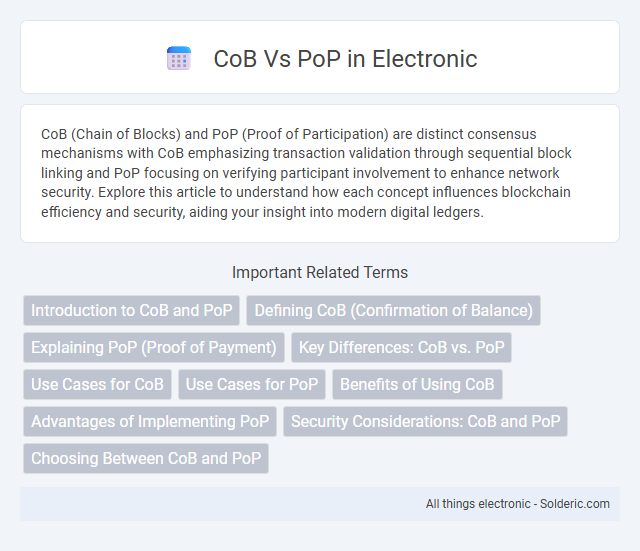CoB (Chain of Blocks) and PoP (Proof of Participation) are distinct consensus mechanisms with CoB emphasizing transaction validation through sequential block linking and PoP focusing on verifying participant involvement to enhance network security. Explore this article to understand how each concept influences blockchain efficiency and security, aiding your insight into modern digital ledgers.
Comparison Table
| Feature | CoB (Close of Business) | PoP (Point of Presence) |
|---|---|---|
| Definition | End of the business day, typically when operations close. | Physical location providing network access to users or customers. |
| Usage Context | Business hours, deadlines, financial transactions cutoff. | Telecommunications, internet networks, data centers connectivity. |
| Industry | Finance, sales, corporate operations. | IT, telecom, networking. |
| Significance | Marks the daily operational cutoff time for business activities. | Allows users to connect to network services locally. |
| Examples | Bank transactions processed by 5 PM CoB. | ISP PoP facilitating customer internet access. |
Introduction to CoB and PoP
CoB (Cluster of Business) and PoP (Point of Presence) are key concepts in telecommunications and network infrastructure. CoB refers to a centralized group of business services or operations within a specific location, optimizing resource management and customer interaction. PoP represents a physical access point where users connect to an internet service provider's network, serving as a critical node for data transmission and network performance.
Defining CoB (Confirmation of Balance)
Confirmation of Balance (CoB) is a critical accounting process used to verify the accuracy of financial account balances at a specific point in time. It involves reconciling records between internal data and external statements to ensure completeness and correctness. Your financial audits rely on CoB to prevent discrepancies and maintain transparent, reliable accounting practices.
Explaining PoP (Proof of Payment)
Proof of Payment (PoP) is a secure method of verifying transactions by providing a digital or physical receipt as evidence that a payment has been made. PoP ensures transparency and trust between parties by offering a verifiable record that includes transaction details such as date, amount, and payment method. Your use of PoP can streamline dispute resolution and enhance financial accountability in both personal and business transactions.
Key Differences: CoB vs. PoP
The key differences between CoB (Cost of Borrowing) and PoP (Proof of Payment) lie in their distinct financial contexts; CoB refers to the total expense incurred by a borrower, including interest and fees, while PoP serves as evidence confirming a transaction or payment has been made. CoB impacts loan agreements and financial planning by influencing borrowing costs, whereas PoP is essential for record-keeping, auditing, and customer verification processes. Understanding these differences clarifies financial responsibilities and transaction transparency in lending and payment systems.
Use Cases for CoB
CoB (Cube-on-Board) technology is ideal for applications requiring high-performance memory integration within a compact footprint, such as in smartphones, gaming consoles, and AI edge devices. Its use in mobile devices enhances data processing speed and power efficiency by stacking memory dies directly on the logic die, reducing latency compared to traditional PoP (Package-on-Package) configurations. CoB is also favored in high-bandwidth memory applications and systems demanding superior thermal management and signal integrity.
Use Cases for PoP
Points of Presence (PoPs) serve as critical nodes in content delivery networks (CDNs) and edge computing, enabling faster content distribution and reduced latency by housing data centers closer to end-users. Use cases for PoP include streaming media services where real-time video delivery must be seamless, online gaming requiring low latency, and IoT applications demanding rapid data processing at the edge. Enterprises leverage PoPs to ensure localized traffic routing, enhance application performance, and support regional compliance with data sovereignty regulations.
Benefits of Using CoB
CoB (Chip-on-Board) technology offers superior electrical performance and reliability due to shorter interconnects and reduced parasitic inductance compared to PoP (Package on Package). It enables more compact designs and enhanced heat dissipation, improving the overall lifespan of your electronic devices. This results in better signal integrity and increased efficiency, making CoB ideal for high-performance applications.
Advantages of Implementing PoP
Implementing Proof of Participation (PoP) enhances network security by actively engaging nodes in consensus, reducing the risk of centralization seen in Consensus of Block (CoB) systems. PoP's energy efficiency lowers operational costs compared to traditional mining methods, making it more sustainable for blockchain ecosystems. Increased stakeholder involvement under PoP fosters decentralized governance, improving transparency and trust within the network.
Security Considerations: CoB and PoP
Security considerations for Chain of Blocks (CoB) emphasize decentralized validation and cryptographic immutability to protect data integrity and prevent tampering. Proof of Participation (PoP) enhances security by requiring active engagement from network participants, reducing the risk of centralization and Sybil attacks. Both mechanisms prioritize trustless consensus but differ in balancing energy efficiency and participant accountability to safeguard blockchain ecosystems.
Choosing Between CoB and PoP
Choosing between CoB (Chip-on-Board) and PoP (Package-on-Package) depends on your device's design priorities such as space efficiency, thermal management, and performance requirements. CoB integrates bare silicon chips directly on a substrate, optimizing size and heat dissipation, while PoP stacks memory and logic chips vertically to maximize component density. Your selection should consider application-specific needs, balancing compactness with manufacturing complexity and potential electrical performance.
CoB vs PoP Infographic

 solderic.com
solderic.com